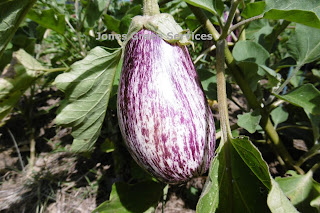This week is chilli week, a highlight of my seed sowing calendar. I love French food and cooking, but when it comes to buying chillies we are pretty much limited to Espelette, the Basque red pepper which have a pleasant enough flavour, if not especially fiery and the doux de Landes pepper, doux meaning soft or mild in this context ... The large supermarkets in the big smoke of Tarbes may have habaneros from time to time, but the supply and quality is unreliable so not worth the trip. Growing chillies it has to be!
Chilli pepper growing is a huge thing, even for non-gardeners so there is a massive amount of (sometimes conflicting) information out there. As a consequence I'm just going to be sticking to what I do; I would recommend reading around the subject if you wish to become an aficionado! Many people grow, not necessarily for the kitchen, but as a horticultural challenge, and sometimes, I suspect, for the kudos of having the hottest chilli in the world (currently one of the nagas, I think) or the funniest (the peter pepper - look it up with care) growing in the greenhouse. Personally, flavour comes first and second; I like a hot chilli, but it has to have flavour as well as heat. Indeed, I'd rather have something mild and tasty, over one that just blisters the mouth!
Hints, tips and general musings from a jobbing gardener in the Hautes Pyrénées.
February - Jobs for the Month
February always feels like the last calm month in my gardening calendar - from the end of the month until the heat of the summer in July I will be dedicating almost every free moment to the sowing, potting on, planting out and caring for my tender vegetables. This month can give us anything from heavy snow to almost summer like conditions, so be prepared to grab the chance to do the important stuff when you can. So if this sounds like me getting my excuses in early for the paucity of new posts, you could be right.
Once we hit July the focus will switch over to preserving as much of the harvest as possible for the winter months; we don't buy in much veg beyond the potatoes and onions which I struggle to grow, so if the harvest or my ability to preserve it fails, then we could be reduced to a very limited winter diet. This is partly choice; we eat seasonally and also try not to buy food that has covered great distances, bananas and the occasional pineapple excepted. Consequently we don't eat warm climate veggies such as tomatoes, peppers or courgettes right through the year. This keeps our small housekeeping budget in check, reduces our carbon footprint and makes the first freshly picked tomato all the more sweet!
Once we hit July the focus will switch over to preserving as much of the harvest as possible for the winter months; we don't buy in much veg beyond the potatoes and onions which I struggle to grow, so if the harvest or my ability to preserve it fails, then we could be reduced to a very limited winter diet. This is partly choice; we eat seasonally and also try not to buy food that has covered great distances, bananas and the occasional pineapple excepted. Consequently we don't eat warm climate veggies such as tomatoes, peppers or courgettes right through the year. This keeps our small housekeeping budget in check, reduces our carbon footprint and makes the first freshly picked tomato all the more sweet!
Subscribe to:
Comments (Atom)
-
As a trying-to-be-self-sufficient gardener I make my own fertiliser from both wild plants growing of their own volition on the plot and from...
-
When we arrived on our field I had not anticipated that a decade on, the garden would still really be rather more field than garden. ...






